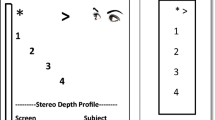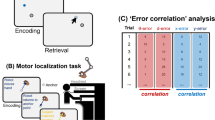Abstract
Human subjects represent the location of a point in 2D space using two independent dimensions (x–y in Euclidean or radius-angle in polar space), and encode location in memory along these dimensions using two levels of representation: a fine-grain value and a category. Here we determined whether monkeys possessed the ability to represent location with these two levels of coding. A rhesus monkey was trained to reproduce the location of a dot in a circle by pointing, after a delay period, on the location where a dot was presented. Five different delay periods (0.5–5 s) were used. The results showed that the monkey used a polar coordinate system to represent the fine-grain spatial coding, where the radius and angle of the dots were encoded independently. The variability of the spatial response and reaction time increased with longer delays. Furthermore, the animal was able to form a categorical representation of space that was delay-dependent. The responses avoided the circumference and the center of the circle, defining a categorical radial prototype around one third of the total radial length. This radial category was observed only at delay durations of 3–5 s. Finally, the monkey also formed angular categories with prototypes at the obliques of the quadrants of the circle, avoiding the horizontal and vertical axes. However, these prototypes were only observed at the 5-s delay and on dots lying on the circumference. These results indicate that monkeys may possess spatial cognitive abilities similar to humans.











Similar content being viewed by others
References
Attneave F (1955) Perception of place in a circular field. Am J Psychol 68:69–82
Chafee MV, Goldman-Rakic PS (1998) Matching patterns of activity in primate prefrontal area 8a and parietal area 7ip neurons during a spatial working memory task. J Neurophysiol 79:2919–2940
Chafee MV, Goldman-Rakic PS (2000) Inactivation of parietal and prefrontal cortex reveals interdependence of neural activity during memory-guided saccades. J Neurophysiol 83:1550–1566
Dale HC (1973) Short-term memory for visual information. Br J Psychol 64:1–8
Funahashi S, Bruce CJ, Goldman-Rakic PS (1989) Mnemonic coding of visual space in the monkey’s dorsolateral prefrontal cortex. J Neurophysiol 61:331–349
Fuster JM (1973) Unit activity in prefrontal cortex during delayed-response performance: neuronal correlates of transient memory. J Neurophysiol 36:61–78
Georgopoulos AP, Kalaska JF, Massey JT (1981) Spatial trajectories and reaction times of aimed movements: effects of practice, uncertainty, and change in target location. J Neurophysiol 46:725–743
Gnadt JW, Andersen RA (1988) Memory related motor planning activity in posterior parietal cortex of macaque. Exp Brain Res 70:216–220
Hernandez A, Salinas E, Garcia R, Romo R (1997) Discrimination in the sense of flutter: new psychophysical measurements in monkeys. J Neurosci 17:6391–6400
Huttenlocher J, Hedges LV, Duncan S (1991) Categories and particulars: prototype effects in estimating spatial location. Psychol Rev 98:352–376
Johnson RA, Wichern DW (1998) Applied multivariate statistical analysis. Prentice Hall, New Jersey
Merchant H, Battaglia-Mayer A, Georgopoulos AP (2003) Interception of real and apparent motion targets: psychophysics in humans and monkeys. Exp Brain Res 152:106–112
Miyashita Y, Hayashi T (2000) Neural representation of visual objects: encoding and top-down activation. Curr Opin Neurobiol 10:187–194
Mountcastle VB, Steinmetz MA, Romo R (1990) Frequency discrimination in the sense of flutter: psychophysical measurements correlated with postcentral events in behaving monkeys. J Neurosci 10:3032–3044
Nairne JS (2002) Remembering over the short-term: the case against the standard model. Annu Rev Psychol 53:53–81
Nelson TO, Chaiklin S (1980) Immediate memory for spatial location. J Exp Psychol 6:529–545
Quintana J, Fuster JM, Yajeya J (1989) Effects of cooling parietal cortex on prefrontal units in delay tasks. Brain Res 503:100–110
Rainer G, Asaad WF, Miller EK (1998) Memory fields of neurons in the primate prefrontal cortex. Proc Natl Acad Sci USA 95:15008–150013
Sandberg EH, Huttenlocher J, Newcombe N (1996) The development of hierarchical representation of two-dimensional space. Child Dev 67:721–739
Smyrnis N, Taira M, Ashe J, Georgopoulos AP (1992) Motor cortical activity in a memorized delay task. Exp Brain Res 92:139–151
Snedecor GW, Cochran WG (1989) Statistical methods. The Iowa State University Press, Ames, Iowa
SPSS (1996) SPSS Base 10.0 User’s Guide. SPSS, Chicago, Ill.
Wright AA (2002) Monkey auditory list memory: tests with mixed and blocked retention delays. Anim Learn Behav 30:158–164
Acknowledgements
We thank P. Gourtzelidis for his comments on the manuscript. This work was supported by United States Public Health Service grant NS17413, the United States Department of Veterans Affairs, and the American Legion Brain Sciences Chair.
Author information
Authors and Affiliations
Corresponding author
Rights and permissions
About this article
Cite this article
Merchant, H., Fortes, A.F. & Georgopoulos, A.P. Short-term memory effects on the representation of two-dimensional space in the rhesus monkey. Anim Cogn 7, 133–143 (2004). https://doi.org/10.1007/s10071-003-0201-z
Received:
Revised:
Accepted:
Published:
Issue Date:
DOI: https://doi.org/10.1007/s10071-003-0201-z




